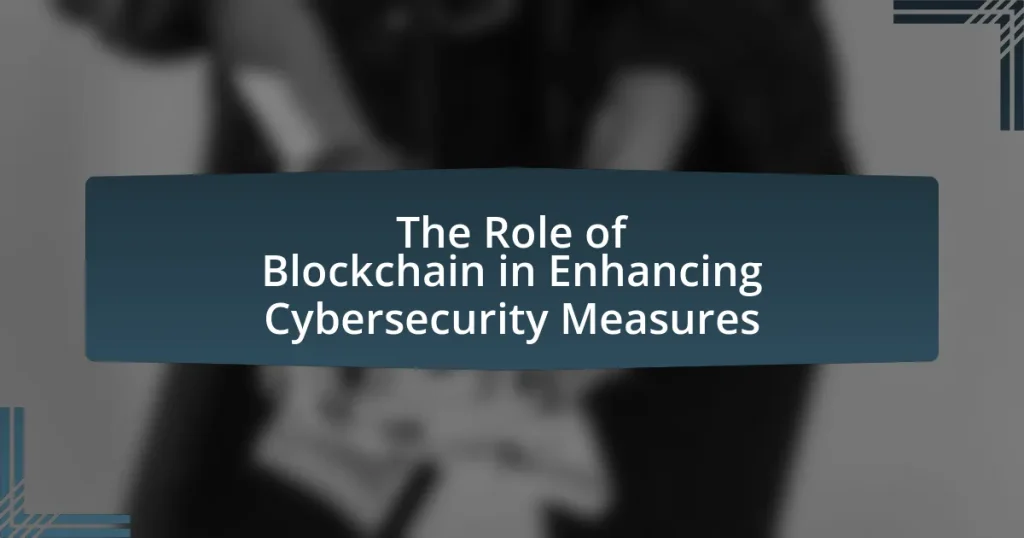The article focuses on the role of blockchain technology in enhancing cybersecurity measures. It outlines how blockchain provides a decentralized and immutable ledger that secures data against unauthorized access and tampering, significantly reducing the risk of data breaches. Key features such as decentralization, cryptographic security, and transparency are discussed, highlighting their contributions to data integrity and incident response. Additionally, the article addresses the challenges traditional cybersecurity measures face and how blockchain can mitigate these issues, along with practical applications in identity management and IoT security. Future trends and best practices for implementing blockchain in cybersecurity are also examined, emphasizing the technology’s potential to transform security protocols across various sectors.

What is the Role of Blockchain in Enhancing Cybersecurity Measures?
Blockchain enhances cybersecurity measures by providing a decentralized and immutable ledger that secures data against unauthorized access and tampering. This technology ensures that once data is recorded on the blockchain, it cannot be altered without consensus from the network, significantly reducing the risk of data breaches. For instance, a study by the National Institute of Standards and Technology (NIST) highlights that blockchain’s cryptographic techniques can protect sensitive information and improve the integrity of data transactions. Additionally, the transparency of blockchain allows for real-time auditing and monitoring, which further strengthens security protocols and helps in identifying potential threats quickly.
How does blockchain technology contribute to cybersecurity?
Blockchain technology enhances cybersecurity by providing a decentralized and immutable ledger that secures data against unauthorized access and tampering. This decentralized nature means that data is distributed across multiple nodes, making it difficult for attackers to compromise the entire system. Additionally, the use of cryptographic algorithms ensures that any changes to the data are easily detectable, as altering one block would require changing all subsequent blocks, which is computationally infeasible. According to a report by the World Economic Forum, blockchain can reduce the risk of data breaches by ensuring that sensitive information is encrypted and only accessible to authorized users, thereby significantly improving overall data integrity and security.
What are the fundamental principles of blockchain that enhance security?
The fundamental principles of blockchain that enhance security include decentralization, immutability, and cryptographic hashing. Decentralization reduces the risk of a single point of failure by distributing data across a network of nodes, making it difficult for attackers to manipulate or compromise the system. Immutability ensures that once data is recorded on the blockchain, it cannot be altered or deleted, providing a reliable and tamper-proof record of transactions. Cryptographic hashing secures data by converting it into a fixed-size string of characters, which is unique to the original data; this process makes it nearly impossible to reverse-engineer or alter the information without detection. These principles collectively contribute to a robust security framework that protects against unauthorized access and fraud.
How does decentralization in blockchain improve data integrity?
Decentralization in blockchain improves data integrity by distributing data across multiple nodes, which reduces the risk of data tampering. Each node maintains a copy of the entire blockchain, and any changes to the data require consensus from the majority of nodes, making unauthorized alterations highly difficult. This consensus mechanism ensures that all transactions are verified and recorded accurately, as seen in Bitcoin’s blockchain, where over 51% of the network must agree for any changes to be accepted. Consequently, the decentralized nature of blockchain creates a robust system that enhances data integrity by making it resilient against single points of failure and malicious attacks.
What are the key features of blockchain that bolster cybersecurity?
The key features of blockchain that bolster cybersecurity include decentralization, immutability, transparency, and cryptographic security. Decentralization reduces the risk of a single point of failure, as data is distributed across multiple nodes, making it difficult for attackers to compromise the entire network. Immutability ensures that once data is recorded on the blockchain, it cannot be altered or deleted, which protects against data tampering and fraud. Transparency allows all participants in the network to view transactions, enhancing accountability and trust. Finally, cryptographic security employs advanced encryption techniques to protect data integrity and confidentiality, making unauthorized access extremely challenging. These features collectively enhance the resilience of systems against cyber threats.
How does cryptography in blockchain protect sensitive information?
Cryptography in blockchain protects sensitive information by using advanced encryption techniques to secure data transactions and maintain privacy. Each transaction is encrypted and linked to the previous one, forming a secure chain that is resistant to tampering. This ensures that only authorized parties can access the information, as the cryptographic keys required to decrypt the data are unique and securely stored. Additionally, the decentralized nature of blockchain means that no single entity has control over the entire network, further enhancing security against data breaches. The use of hashing algorithms, such as SHA-256, ensures that any alteration of the data is easily detectable, providing an additional layer of protection.
What role does consensus mechanism play in securing blockchain networks?
The consensus mechanism is crucial for securing blockchain networks as it ensures agreement among distributed nodes on the validity of transactions. By requiring multiple participants to validate and confirm transactions, consensus mechanisms like Proof of Work or Proof of Stake prevent malicious actors from easily altering the blockchain. This decentralized validation process enhances security by making it difficult for any single entity to control the network or manipulate data, thereby maintaining the integrity and trustworthiness of the blockchain.
What challenges does blockchain address in traditional cybersecurity measures?
Blockchain addresses several challenges in traditional cybersecurity measures, primarily by enhancing data integrity, decentralization, and transparency. Traditional cybersecurity often relies on centralized systems, which are vulnerable to single points of failure and attacks. In contrast, blockchain’s decentralized nature distributes data across a network, making it significantly harder for malicious actors to compromise the entire system.
Additionally, blockchain employs cryptographic techniques that ensure data integrity, meaning that any alteration of data is easily detectable. This contrasts with traditional systems where data tampering can go unnoticed. Furthermore, the transparency of blockchain allows for real-time auditing and monitoring, which enhances accountability and reduces the risk of insider threats.
These characteristics of blockchain provide a robust framework for addressing the limitations of traditional cybersecurity measures, as evidenced by its increasing adoption in sectors requiring high security, such as finance and healthcare.
How does blockchain mitigate risks of data breaches?
Blockchain mitigates risks of data breaches by providing a decentralized and immutable ledger for data storage. This structure ensures that once data is recorded, it cannot be altered or deleted without consensus from the network, significantly reducing the likelihood of unauthorized changes. Additionally, blockchain employs cryptographic techniques to secure data, making it difficult for attackers to access or manipulate sensitive information. For instance, a study by the World Economic Forum highlights that blockchain’s transparency and traceability can enhance accountability, further deterring malicious activities.
What are the limitations of conventional cybersecurity solutions that blockchain overcomes?
Conventional cybersecurity solutions often face limitations such as centralized control, vulnerability to single points of failure, and lack of transparency. Blockchain technology overcomes these limitations by decentralizing data storage, which eliminates single points of failure and enhances resilience against attacks. Additionally, blockchain’s immutable ledger provides transparency and traceability, allowing for better auditing and accountability in cybersecurity practices. For instance, a study by the World Economic Forum highlights that blockchain can significantly reduce the risk of data breaches by distributing data across a network rather than storing it in a single location.
How can organizations implement blockchain for enhanced cybersecurity?
Organizations can implement blockchain for enhanced cybersecurity by utilizing its decentralized and immutable ledger technology to secure data transactions and improve authentication processes. This approach reduces the risk of data breaches, as blockchain’s distributed nature makes it difficult for unauthorized parties to alter or access sensitive information. For instance, a study by the World Economic Forum highlights that blockchain can enhance identity management systems, allowing organizations to verify user identities without relying on a central authority, thereby minimizing single points of failure. Additionally, smart contracts can automate security protocols, ensuring that transactions are executed only when predefined conditions are met, further safeguarding against cyber threats.
What are the potential risks associated with using blockchain in cybersecurity?
The potential risks associated with using blockchain in cybersecurity include vulnerabilities in smart contracts, the immutability of erroneous data, and the reliance on cryptographic algorithms. Smart contracts can contain coding errors that may be exploited, leading to unauthorized access or loss of assets. Additionally, once data is recorded on a blockchain, it cannot be altered, which means that any incorrect or malicious data remains permanently accessible, potentially compromising security. Furthermore, the security of blockchain systems depends heavily on the strength of the cryptographic algorithms used; if these algorithms are broken or become obsolete, the entire system may be at risk.

What are the practical applications of blockchain in cybersecurity?
Blockchain has several practical applications in cybersecurity, primarily enhancing data integrity, improving identity management, and facilitating secure transactions. By utilizing a decentralized ledger, blockchain ensures that data cannot be altered retroactively, which significantly reduces the risk of data breaches and unauthorized access. For instance, in identity management, blockchain can provide a secure method for verifying identities without relying on a central authority, thereby minimizing the risk of identity theft. Additionally, blockchain technology can secure transactions through cryptographic techniques, ensuring that data exchanged between parties remains confidential and tamper-proof. These applications are supported by various studies, including a report by the World Economic Forum, which highlights blockchain’s potential to transform cybersecurity by providing robust solutions against cyber threats.
How is blockchain used in identity management?
Blockchain is used in identity management by providing a decentralized and secure method for storing and verifying identities. This technology enables individuals to control their personal information, reducing the risk of identity theft and fraud. For instance, blockchain allows for the creation of self-sovereign identities, where users can manage their credentials without relying on a central authority. A study by the World Economic Forum highlights that blockchain can enhance identity verification processes, making them more efficient and secure by utilizing cryptographic techniques to ensure data integrity and authenticity.
What benefits does blockchain offer for user authentication?
Blockchain offers enhanced security, decentralization, and transparency for user authentication. By utilizing cryptographic techniques, blockchain ensures that user identities are securely stored and verified, reducing the risk of unauthorized access. The decentralized nature of blockchain eliminates single points of failure, making it more resilient against attacks. Additionally, the transparency of blockchain allows for real-time auditing and tracking of authentication processes, which can help in identifying and mitigating potential security breaches. These features collectively contribute to a more robust and trustworthy user authentication system.
How does blockchain enhance privacy in identity verification processes?
Blockchain enhances privacy in identity verification processes by enabling decentralized and secure storage of identity data. This technology allows individuals to control their own identity information, sharing only necessary data with verifiers without exposing the entire identity. For instance, zero-knowledge proofs, a feature of blockchain, allow one party to prove to another that they know a value without revealing the value itself, thus maintaining privacy. Additionally, the immutable nature of blockchain ensures that once identity data is recorded, it cannot be altered or tampered with, further protecting against identity theft and fraud.
What role does blockchain play in securing IoT devices?
Blockchain plays a crucial role in securing IoT devices by providing a decentralized and immutable ledger for data transactions. This technology enhances security by ensuring that data exchanged between IoT devices is encrypted and tamper-proof, reducing the risk of unauthorized access and data breaches. For instance, a study published in the journal “IEEE Internet of Things Journal” highlights that blockchain can facilitate secure device authentication and data integrity, which are essential for maintaining the confidentiality and reliability of IoT networks. By leveraging smart contracts, blockchain can automate security protocols, ensuring that only authorized devices can communicate, thus further safeguarding the IoT ecosystem.
How does blockchain prevent unauthorized access to IoT networks?
Blockchain prevents unauthorized access to IoT networks by providing a decentralized and immutable ledger that enhances security and trust among devices. Each IoT device can be assigned a unique cryptographic identity, allowing for secure authentication and authorization processes. This ensures that only verified devices can communicate within the network, significantly reducing the risk of unauthorized access.
Moreover, the use of smart contracts on the blockchain automates access control, enabling predefined rules for device interactions that are enforced without the need for a central authority. This decentralized approach minimizes single points of failure, making it more difficult for attackers to compromise the network.
Additionally, the transparency of blockchain allows for real-time monitoring of device activities, enabling quick detection of any anomalies or unauthorized attempts to access the network. This combination of unique identities, automated access control, and real-time monitoring collectively fortifies IoT networks against unauthorized access.
What are the implications of blockchain for IoT data integrity?
Blockchain significantly enhances IoT data integrity by providing a decentralized and immutable ledger for data transactions. This technology ensures that data generated by IoT devices is securely recorded and cannot be altered retroactively, which mitigates risks of tampering and unauthorized access. For instance, a study published in the IEEE Internet of Things Journal highlights that blockchain can prevent data manipulation in IoT ecosystems by enabling transparent and verifiable data sharing among devices. This capability is crucial for applications such as smart cities and healthcare, where accurate data is essential for decision-making and operational efficiency.
How can blockchain improve incident response and recovery?
Blockchain can improve incident response and recovery by providing a secure, immutable ledger for tracking incidents and responses. This technology enables real-time data sharing among stakeholders, ensuring that all parties have access to the same information, which enhances coordination and reduces response times. Additionally, the transparency of blockchain allows for better auditing and analysis of incidents, facilitating more effective recovery strategies. For instance, a study by the World Economic Forum highlights that blockchain can streamline communication during cyber incidents, leading to faster identification and mitigation of threats.
What advantages does blockchain provide in tracking security incidents?
Blockchain provides enhanced transparency and immutability in tracking security incidents. This technology allows for the creation of a decentralized ledger where all security events are recorded in a tamper-proof manner, ensuring that once data is entered, it cannot be altered or deleted. For instance, a study by the World Economic Forum highlights that blockchain can improve incident response times by providing real-time access to incident data, which is crucial for effective threat management. Additionally, the decentralized nature of blockchain reduces the risk of a single point of failure, making it more resilient against attacks.
How does blockchain facilitate faster recovery from cyberattacks?
Blockchain facilitates faster recovery from cyberattacks by providing a decentralized and immutable ledger that ensures data integrity and availability. In the event of a cyberattack, organizations can quickly restore their systems to a previous state using the unaltered records stored on the blockchain. This rapid recovery is possible because blockchain technology allows for real-time data replication across multiple nodes, reducing downtime and minimizing data loss. Additionally, the transparency and traceability of blockchain transactions enable organizations to identify the source of the breach and implement corrective measures more efficiently.

What are the future trends of blockchain in cybersecurity?
Future trends of blockchain in cybersecurity include enhanced data integrity, decentralized identity management, and improved threat detection. Enhanced data integrity is achieved through blockchain’s immutable ledger, which ensures that any alterations to data can be easily tracked and verified. Decentralized identity management allows users to control their personal information, reducing the risk of identity theft and data breaches. Improved threat detection is facilitated by blockchain’s ability to provide real-time monitoring and analysis of network activities, enabling quicker responses to potential threats. These trends are supported by the increasing adoption of blockchain technology across various sectors, as evidenced by a report from Gartner, which predicts that by 2025, 75% of organizations will be using blockchain for cybersecurity purposes.
How is the adoption of blockchain expected to evolve in cybersecurity?
The adoption of blockchain in cybersecurity is expected to evolve significantly as organizations increasingly recognize its potential to enhance data integrity and security. Blockchain technology provides a decentralized and immutable ledger, which can help prevent data tampering and unauthorized access, thereby addressing critical vulnerabilities in traditional cybersecurity frameworks. According to a report by Gartner, by 2025, 70% of organizations will be using blockchain technology to improve their cybersecurity measures, highlighting a growing trend towards integrating blockchain solutions to bolster security protocols. This evolution is driven by the need for more robust security mechanisms in response to rising cyber threats and data breaches.
What emerging technologies are likely to integrate with blockchain for enhanced security?
Emerging technologies likely to integrate with blockchain for enhanced security include artificial intelligence (AI), the Internet of Things (IoT), and quantum computing. AI can analyze vast amounts of data to detect anomalies and potential threats in real-time, while blockchain provides a secure and immutable ledger for these transactions, enhancing overall security. IoT devices can benefit from blockchain by ensuring secure communication and data integrity, as blockchain can authenticate devices and manage their identities. Quantum computing poses a potential threat to current encryption methods, but it can also be integrated with blockchain to develop new cryptographic techniques that enhance security measures. These integrations are supported by ongoing research and development in cybersecurity, demonstrating the potential for blockchain to bolster security across various emerging technologies.
How can regulatory frameworks impact the use of blockchain in cybersecurity?
Regulatory frameworks can significantly influence the adoption and implementation of blockchain technology in cybersecurity by establishing guidelines that ensure compliance, security, and trust. These frameworks can dictate how data is stored, shared, and protected, thereby shaping the operational landscape for blockchain applications. For instance, regulations such as the General Data Protection Regulation (GDPR) in Europe impose strict data privacy requirements that blockchain solutions must adhere to, affecting their design and functionality. Additionally, regulatory clarity can encourage investment and innovation in blockchain technologies by reducing uncertainty, as seen in jurisdictions that have embraced blockchain-friendly regulations, leading to increased development of secure applications.
What best practices should organizations follow when implementing blockchain for cybersecurity?
Organizations should follow several best practices when implementing blockchain for cybersecurity, including ensuring data integrity, enhancing transparency, and utilizing smart contracts. Ensuring data integrity involves using cryptographic hashing to secure data, making it tamper-proof and verifiable. Enhancing transparency allows stakeholders to audit transactions in real-time, which can help detect anomalies and unauthorized access. Utilizing smart contracts automates processes and reduces human error, thereby increasing security. These practices are supported by the inherent characteristics of blockchain technology, such as decentralization and immutability, which collectively strengthen cybersecurity measures.
How can organizations ensure the security of their blockchain implementations?
Organizations can ensure the security of their blockchain implementations by employing robust cryptographic techniques, conducting regular security audits, and implementing strict access controls. Cryptographic methods, such as hashing and digital signatures, protect data integrity and authenticity, making it difficult for unauthorized parties to alter information. Regular security audits help identify vulnerabilities and ensure compliance with security standards, while strict access controls limit user permissions, reducing the risk of insider threats. According to a report by the World Economic Forum, organizations that adopt these practices can significantly mitigate risks associated with blockchain technology.
What are the key considerations for training staff on blockchain security measures?
Key considerations for training staff on blockchain security measures include understanding the fundamental principles of blockchain technology, recognizing potential vulnerabilities, and implementing best practices for secure transactions. Staff must be educated on the decentralized nature of blockchain, which reduces single points of failure, yet requires awareness of social engineering attacks that can compromise security. Additionally, training should cover regulatory compliance and the importance of maintaining data integrity, as breaches can lead to significant financial and reputational damage. According to a report by the World Economic Forum, 10% of organizations have experienced a blockchain-related security incident, highlighting the necessity for comprehensive training programs to mitigate risks effectively.










